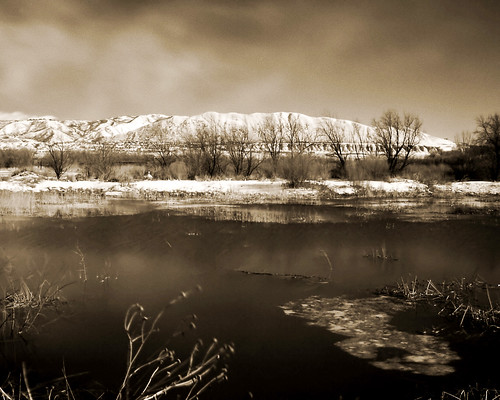Relief from yesterday's Clash
Wow, did the color in yesterday's post clash with the rest of the page or what? If you missed it, click here and see for yourself. Yeesh, what was I thinking with that post? Well as a relief from that blogging faux pas I have posted an image that will hopefully be better suited for its webpage surroundings.
As I mentioned yesterday, I picked up an R72 infrared filter to experiment with. This filter is so dark red that it is nearly black. I'm not an expert in infrared technology, but from what I have read this filter cuts out much of the visible light we see with our naked eye and just lets in the infrared. This can result in very dramatic black & white photographs.
So far I haven't been overly impressed with my results, but I really need to do some more trials. This particular shot was made with the filter on my lens. Even though it was a bright sunny day, due to the density of the filter this capture required a 30 second shutter speed.
Canon 30D, Canon 24-105 f/4L lens - 30 Seconds, f/22, ISO 100




2 Comments:
You probably know all this, but just in case I've happened upon an IR site you haven't... A couple thoughts, all based on what I've gathered from others; zero personal experience.
1) A mix of folliage with cloudy skies gives the most dramatic results due to the greater differences in IR reflection between plant life and other surfaces. Foliage is something we have in short supply around here this time of year.
2) With IR, the dynamic range is much more limited. Where normally there are 5 f-stops (or is it 8, I forget now) between black and white to work with, with IR I think it's about half normal. So try scenes which normally would look flatter, with IR you might get more detail.
3) Most of the shots I've been looking at on IR sites have a wider aperature with a shorter time than what you've been using on your posted photos; e.g. f/4 at 2s. I wonder if the differences (e.g. motion blur) due to this might be part of what you're picking up on.
4) The achromatic adjustments built into the lens to make all three color bands have the same focal length are biased for visible light. With IR you may start to get different focal lengths for each of the three colors, throwing focus off between the red, green and blue components. A couple recommendations (from the web sites): let auto-focus do its thing, assuming there's enough light for it to work, varies from camera to camera and filter to filter; in post, look at each color layer to see if one is out of focus more than the others and try to adjust; in manual mode, focus without the filter, put the filter on and then take a bunch of shots, each time moving the focus just a tad.
Just my $0.01 (50% discount due to not knowing anything about this ;-).
P.S. I didn't notice a clash with the colors until you pointed it out; and even then it didn't hurt too bad. I think the black border buffered it for me.
Post a Comment
<< Home